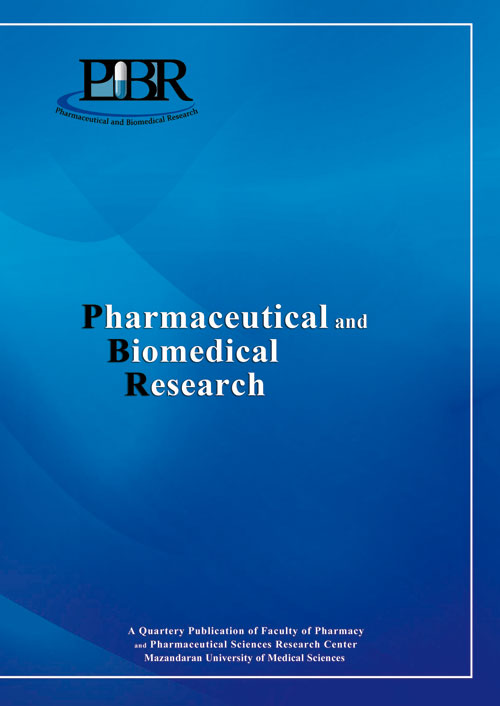فهرست مطالب

Pharmaceutical and Biomedical Research
Volume:3 Issue: 3, Sep 2017
- تاریخ انتشار: 1396/07/11
- تعداد عناوین: 5
-
-
Pages 1-11Curcumin is a polyphenol extracted from the Curcuma plant. Curcumin has been used widely in ayurvedic medicine for centuries; it has a variety of biological properties including anti-oxidant, analgesic, anti-inflammatory and antiseptic activity. Curcumin has shown anti-cancer activities through variety of biological pathways engaged in mutagenesis, oncogene expression, cell cycle regulation, apoptosis, tumorigenesis and metastasis. Curcumin has proved anti-proliferative effect in many cancers, and is an inhibitor of the transcription factor NF-κB and downstream gene products (including c-myc, Bcl-2, COX-2, NOS, Cyclin D1, TNF-α, interleukins and MMP-9). Furthermore, curcumin affects a variety of growth factor receptors and cell adhesion molecules involved in tumor growth, angiogenesis and metastasis. However, a limiting factor is its extremely low bioavailability which hinders its use as therapeutic agent. Therefore, many technologies have been developed to overcome this limitation. We summarize to develop curcumin delivery aims and increase solubility for improving curcumin bioavailability and anticancer potential for therapy.Keywords: Curcumin, apoptosis, anti-proliferative, metastasis, anti-inflammatory, antiseptic activity
-
Pages 12-16Cold atmospheric plasma (CAP) has received great attention due to its noteworthy ability, and has also been widely studied over few decades in physics, biology and medicine. The purpose of this study is to evaluate the cold atmospheric pressure plasma effects on the proliferation of breast cancer cells. MDA-MB-231 was used for this experiment. MDA-MB-231 cells were cultured in 24-well plate and treated with non-thermal plasma. The viability of the cancer cells was determined by MTT assay. Different input power was applied in this experience (20-35W), and treatment time was between 5s and 25s. For reducing thermal damage, gas temperature was less than 37 ˚C. The Viability of breast cancer cells was significantly decreased after plasma treatment. The results showed that viability was decreased with an increment of plasma power and plasma exposure time. These results suggest that non-thermal atmospheric pressure plasma could strongly have cytotoxicity effect on cancerous breast cell.Keywords: non-thermal plasma, cancer cells, cell viability, MTT assay, MDA-MB-231
-
Pages 17-22The aim of this study is whether oxidative stress markers, homocysteine (Hcy), cardiac troponin I (cTnI) and the activity of adenosine deaminase (ADA) alter following administration of different doses of sertraline. Sixty male Wistar rats were assigned into four groups. Sertraline at doses of 20, 40 and 80 mg / kg / day) were administered to three groups through gastric gavage for 90 days. The fourth group was received only distilled water. After 90 days of sertaline administration, the levels of oxidative stress biomarkers in plasma were measured. The results revealed remarkable elevation in malondialdehyde (MDA) and considerable reduction in Hcy, cTnI, antioxidant enzymes levels as superoxide dismutase (SOD), glutathione peroxidase (GSH-Px), catalase and paraoxonase (PON)and ADA activity in the rats that were receive sertraline at dose of 80 mg /Kg /day. The results denoted that sertraline administration at the dose of 80 mg/kg/day reduce cardiovascular biomarkers. Meanwhile, decrease of ADA activity may suggest reduction of immune function due to sertraline administration.Keywords: Sertraline, Biochemical parameters, rat
-
Pages 23-30Despite preventive measures, incidence of burns is still one of the important medical problems. Nowadays, it has been suggested that some strains of probiotic bacteria have beneficial effects in treatment of skin injures like skin wounds. The aim of the present study was to evaluate the effects of Lactobacillus acidophilus on second-degree burn wounds in rats. Second-degree burn wounds were induced on the back of the 60 Wistar rats by contacting of a heated aluminum bar. After that, the rats randomly assigned to negative control (received no treatment), vehicle control (received Eucerin, daily) and experimental (received daily, an ointment of bacteria in Eucerin) groups. Macroscopic assessment of wound healing was conducted by calculating the percent of wound healing in days 3, 7 and 14 post-burn. Moreover, wound samples were harvested for microscopic evaluation of wound area. The results showed that in the experimental groups, the percent of wound healing, in the 3th and 7th days of experiments was significantly higher than control group. Moreover, in addition to prevention of burn infection, the bacteria had beneficial effects on different aspects of wound healing processes like reducing the inflammatory response and accelerating the granulation tissue formation and re-epithelialization. Overall, the present study showed that the treatment of burn wounds with L. acidophilus might accelerate the healing processes of second-degree burn wounds.Keywords: Lactobacillus acidophilus, Probiotics, Topical, Burn wound, Rats
-
Pages 31-37Exposure to selective serotonin reuptake inhibitors causes pupillary dilator muscle stimulation, active mydriasis, rapid rise in the level of the intraocular pressure (IOP), damage to the optic nerve at the back of the eye, and ultimately leads to acute angle closure glaucoma. The aim of this study was to assess the effects of sertraline on the levels of IOP and cup-to-disc ratio (CDR) in patients with anxiety disorders or mixed anxiety and depressive disorder or major depressive under daily treatment with sertraline and without underlying eye disease for three months. In this study,30 eligible patients in the sertraline group and 30 healthy volunteers in the control group include the study and were referred to an ophthalmologist. Ophthalmologic examinations were assessed at the baseline and on the first and third months of the study. The average daily dose of sertraline was 95±2.5 mg.During the study, the IOP changes in the sertraline and control groups were 0.26±0.43 and 0.00±0.00 mmHg (pKeywords: Selective serotonin, reuptake inhibitors, Intraocular pressure, Cup-to-disc ratio

